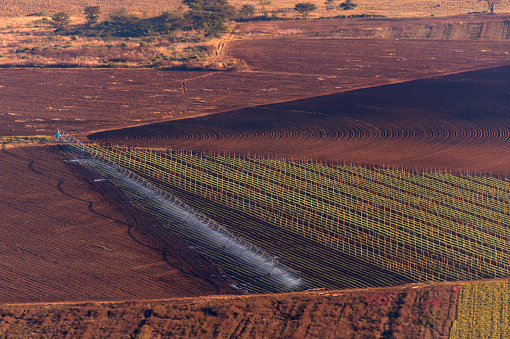Bensen Muzamba knows the cost of water only too well. He runs a maize farm outside Harare, Zimbabwe’s capital, but because of poor rains at the start of the season, he was forced to purchase water to irrigate his crop – something he can ill afford.
As with many farmers across the country, he relies on rainfall – and struggles if it does not come when expected.
“It’s tough when you have to buy water … and sellers demand foreign currency,” Muzamba told the Thomson Reuters Foundation, inspecting maize plants on his land about 15 km (9 miles) from Harare.
As Zimbabwe struggles with the fallout from a slow start to the rainy season, bulk suppliers that deliver water in tankers have increased their prices, citing the high cost of extracting groundwater.
And with dam levels down – though recent rains have helped – cities like Bulawayo have been exploring ways to curb water consumption in homes.
Loading...
Meanwhile, violent clashes have erupted over shortages of fuel and a government-imposed fuel price hike, while U.S. dollars, one of Zimbabwe’s main currencies, are hard to come by.
Groundwater is essential to ensure farmers can grow enough food crops. But some borehole owners in Harare have been selling 1,000 liters of water for about $30, twice the going rate in October.
The Zimbabwe National Water Authority (ZINWA), a government agency, charges $10 for 1,000 liters from state-owned dams – but even that is expensive for farmers used to free rain.
Washington Zhakata, director of the climate change department at the Ministry of Lands, Agriculture, Water, Climate and Rural Resettlement, said declining rainfall in the past couple of decades had caused Zimbabwe’s groundwater levels to fall and shortened the time periods in which water is available.
This, he said, had affected farming nationwide.
“The distribution of rainfall across the country has been uneven, coupled with extended dryness,” Zhakata said by email, linking the shifts to global warming.
Average temperatures around the world have already risen about 1 degree Celsius above pre-industrial times, and southern Africa is expected to see drier conditions as warming continues.
Sobona Mtisi, an independent researcher on water and climate change in Zimbabwe, said rainfall had been low but the nation had enough groundwater stocks to meet rising demand.
Still, Zimbabwe would benefit from better methods for managing its groundwater, he added.
“(It) needs to be managed sustainably through an effective and evidence-based groundwater policy,” said the UK-based Mtisi.
Despite rains having picked up this month, forecasters’ concerns persist that an El Nino weather pattern could result in below-average rainfall this season, said Tamburiro Pasipangodya of the Zimbabwe Meteorological Services Department.
Up to early January, most parts of the country had received less than 75 percent of the long-term average rainfall, and a smaller amount than in the past three seasons, she noted.
The Famine Early Warning Systems Network said seasonal rainfall was set to continue across southern Africa this week, bringing some relief from dryness, including to parts of Zimbabwe.
TURNING OFF THE TAP
As rains become more erratic, Zimbabwe is looking to irrigation to cushion its food supplies against drought.
In announcing the 2019 budget in November, Finance Minister Mthuli Ncube allocated nearly $1 billion to the agriculture ministry to fund irrigation and borehole rehabilitation, among other measures to improve water sources for farmers.
And in a bid to deal with the long-term effects of patchy rainfall, the southwestern city of Bulawayo is proposing technological interventions to cut water consumption.
In the last week of December, water levels in Bulawayo’s dams dropped to 60 percent, from 65 percent in early November, ZINWA said.
Turning plastic into profit in Somalia
The city has long turned to groundwater for relief during dry spells, but a recent council report said the municipality had failed to maintain its boreholes, compromising future water availability.
This month, the Bulawayo authorities said they were looking at installing water flow regulators in homes.
According to the city’s director of engineering services, Simela Dube, the devices would be part of water management efforts allowing consumers and the municipality to save water.
The regulators would restrict consumption to pre-determined levels decided by households, depending on how much water they need, he told council chambers.
Residents would be able to use between 1 and 5 cubic meters of water per day, compared with now when can turn on their taps at will even if they cannot pay their water bill.
However, there are concerns the new proposal will meet resistance from customers who have previously rejected pre-paid water meters, said city councillor Sikhulilekile Moyo, calling for more consultation.
Jacob Mafela of the Bulawayo Residents Association told the Thomson Reuters Foundation that schemes to save water were generally welcome.
“We support all initiatives which at the end of the day benefit residents,” he said. “It is historically known that the city faces water challenges, but we need consensus.”
Meanwhile, as El Nino-linked rainfall uncertainty continues, farmers like Muzamba – most of whom lack insurance against crop failures – are despairing of help.
“We will keep asking government for assistance – though we know the money is not there,” he said.
Loading...
